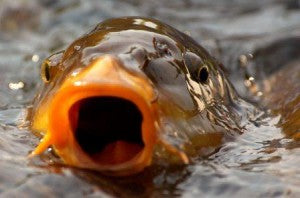I remember in my early years of ponding my first encounter with spawning. One early summer morning, I noticed something different happening in my pond. My first visual clue was a pond full of white foam as well as, a strong fishy smell. My first thought and concern was that there had been predators in the water stirring up the water. After doing some research, I realized that my koi were spawning. How exciting! So, you want to understand more? Keep reading!
Under normal conditions, distinguishing between male and female fish can be quite difficult. Females normally have a larger girth to them and during the spawning months, they will have a swollen underside. This swollenness is a result of hundreds of eggs waiting to be released.
When the fish spawn, you may notice several thinner males chasing the female(s) around the pond. They will bump against her sides and stomach area in an attempt to release her eggs. Once her eggs are released, the males will release their milt, fertilizing the eggs as they adhere to underwater plant life or some other shelter. Without some form of proper shelter for the newly created fry, adult koi will eat their young. Mother Nature does provide her own way of keeping fish populations in check this way.
I have my own experience with actually transplanting water hyacinth from a larger pond to a smaller pond. It was later that I realized the water hyacinth roots had koi eggs housed in them. These fry successfully lived in the smaller pond. I initially fed them koi food crumbs until they grew big enough to eat “big fish” food.
More important spawning information to consider:
- Spawning occurs between March- July, or when water temperatures are between 68°F – 72°F.
- Spawning normally occurs in the early morning hours or late evening.
- Healthy eggs will be translucent while unfertilized eggs will be white and will start to grow fuzz.
- Keep water quality in check to assure a healthy environment for spawning to occur.
- To ensure survival of some of your fry, provide shelter using plants or manufactured spawning ropes and brushes or isolation.



